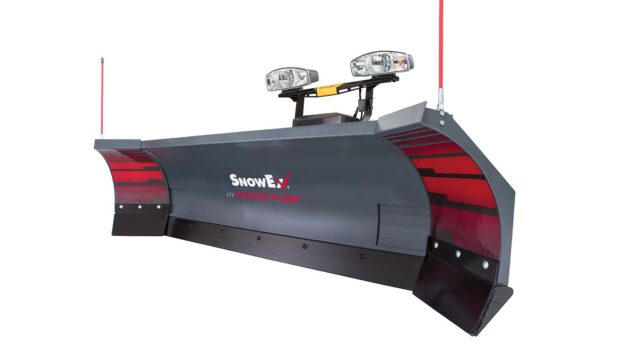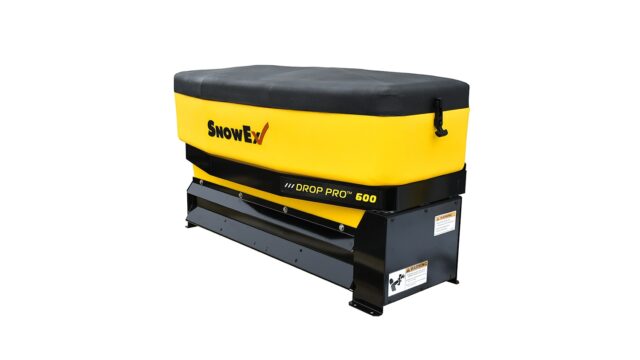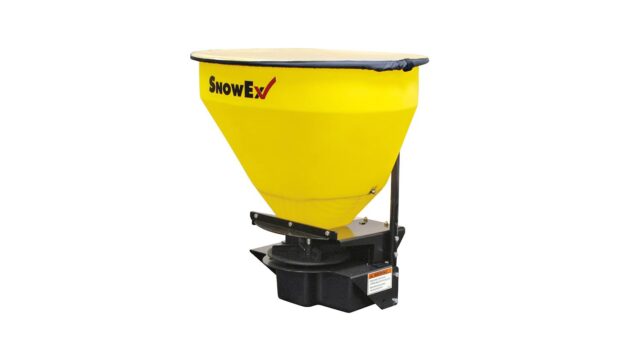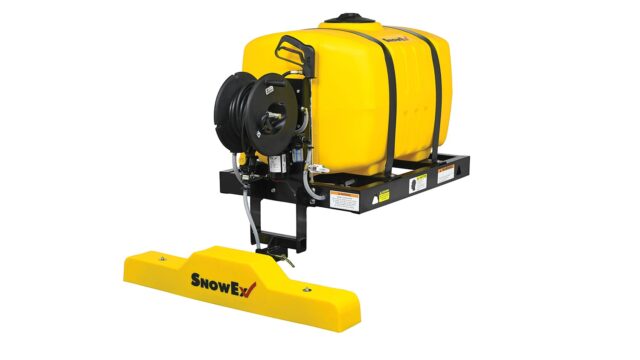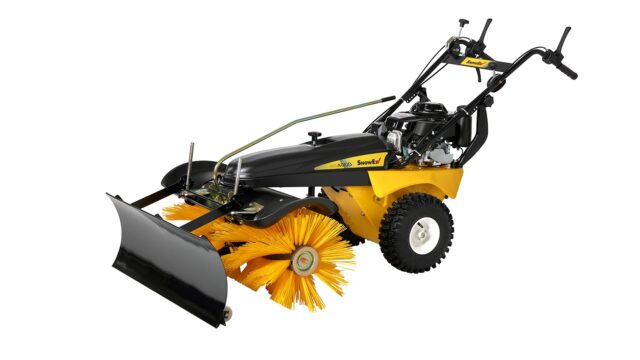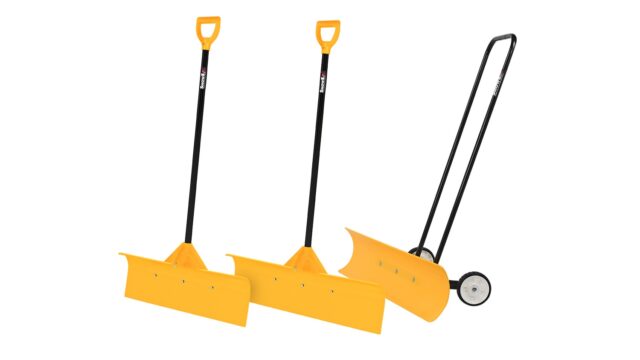Essential Tools for Mastering the Art & Science of Snowfighting
Created April 3, 2020

By Pam Buckley, Sustainability Manager, Douglas Dynamics
Having the right tools and knowing how and when to use them are the keys to success with any job. When a winter storm hits, commercial snowfighters have a limited timeframe to deliver on the service goals specified in their contracts. For them, having the right tools can make the difference between getting by and getting ahead.
The ‘essentials’ of commercial winter operations fall into three major categories: Equipment, Materials and Training. Since each storm presents a unique set of conditions, the right tools will vary accordingly, making it critically important for snowfighters to plan ahead to ensure they have all the essentials in their arsenal. Until recently, the typical service provider has felt well-equipped utilizing a standard line-up of plows, blowers, and spreaders with solid deicers and sand – all important tools, but short one of the essentials … Liquids.
Liquid Ice Control Strategies
Liquids are an indispensable tool for executing two of the three fundamental snowfighting strategies – anti-icing and deicing, and, when used appropriately, they expedite the third – plowing.
Anti-icing is a Proactive Measure. The Best Management Practice calls for a light application (est. 18-35 gallons per acre) of a liquid deicer sprayed directly on bare pavement just prior to, or at the onset of, a storm to inhibit snow and ice from bonding to the pavement surface and expedite plowing.
Deicing is a Reactive Measure. The Best Management Practice is to pre-wet solids in the auger or chute with a liquid deicer during spreading operations to accelerate the brining process for the purpose of penetrating and breaking an established ice-to-pavement bond.
The benefits of liquid applications for ice control are well documented and include reductions in salt usage, faster response times, improved environmental impacts, and savings in time, labor and fuel. Optimal achievement of those benefits is both an art and a science. The chemical properties of liquid deicing materials and their performance is a proven science, but deciding how and when to use them effectively requires knowledge that only experience provides … the ‘art.’ Liquid equipment technologies represent the state of the ‘science’ in ice control and are beginning to trend heavily with innovative service providers seeking to achieve a competitive edge in today’s market.
In each of the following areas, SnowEx® provides innovative, purpose-built liquid equipment specifically tailored to the unique challenges of the commercial market to make it easy to integrate liquids into an overall ice control strategy.
Before, during or after the storm, the well-equipped snowfighter must have the right tools in each of these categories to obtain optimum results in the shortest time and at the lowest cost.
Equipment Solutions
Liquid Application Equipment
| Type | Anti-icing and Select Deicing Applications |
|---|---|
| Truck Mounted Sprayers | Roads, Streets, Parking Lots, Pretreating Stockpiles |
| Truck Mounted Sprayers | Roads, Streets, Parking Lots, Pretreating Stockpiles |
| Utility Mounted Sprayers | Sidewalks, Bike Paths, Driveways, Curbs, Stairs, Pretreating Stockpiles |
| Utility Mounted Sprayers | Sidewalks, Bike Paths, Driveways, Curbs, Stairs, Pretreating Stockpiles |
| Push Sprayers | Sidewalks, Stairs, Curbs, Cart Corrals |
| Push Sprayers | Sidewalks, Stairs, Curbs, Cart Corrals |
Granular Spreaders with Pre-Wet Systems
| Type | Anti-icing and Select Deicing Applications |
|---|---|
| Truck Mounted Spreaders w/ Pre-Wet Systems | Streets and Parking Lots |
| Truck Mounted Spreaders w/ Pre-Wet Systems | Streets and Parking Lots |
| Utility Mounted Spreaders w/ Pre-Wet Systems | Sidewalks, Bike Paths, Driveways |
| Utility Mounted Spreaders w/ Pre-Wet Systems | Sidewalks, Bike Paths, Driveways |
Material Production, Storage and Transfer Systems
| Type | |
|---|---|
| Brine Maker | 23.3% Salt Brine production |
| Brine Maker | 23.3% Salt Brine production |
| Storage Tanks | Storage for Salt Brine |
| Storage Tanks | Storage for Salt Brine |
| Liquid Transfer System | Transfer Brine from Storage to Truck Spray System |
| Liquid Transfer System | Transfer Brine from Storage to Truck Spray System |
Material Solutions
The Basics
The basic building blocks of most deicers include the following three chlorides, which can be used in both liquid and granular forms. The eutectic temperature represents the freeze point of the deicer while the effective temp is the lowest practical or cost-effective temperature for using the material. Hence the effective temperature can be impacted by material supply factors, such as regional availability and cost.
| Basic CHlorides | Effective Temp | Eutectic Temp | Concentration |
|---|---|---|---|
| NaCl (sodium chloride) naturally a solid | 15°F | -6°F | 23.3% |
| NaCl (sodium chloride) naturally a solid | 15°F | -6°F | 23.3% |
| CaCl2 (calcium chloride) naturally a liquid | -25°F | -60°F | 29.8% |
| CaCl2 (calcium chloride) naturally a liquid | -25°F | -60°F | 29.8% |
| MgCl2 (magnesium chloride) naturally a liquid | -10°F | -28°F | 21.6% |
| MgCl2 (magnesium chloride) naturally a liquid | -10°F | -28°F | 21.6% |
Please note these temperatures refer to pavement surface temperature, not air temperature.
With a eutectic temperature of -17.5°F, Calcium Magnesium Acetate (CMA) is a costly non-chloride deicer most commonly used as a liquid on bridges, parking decks and areas where chlorides are restricted or sustainability is of utmost importance.
Salt Brine
According to the 2013 Edition of the Salt Institute’s Snowfighter’s Handbook, “Research has shown that timely applications of anti-icing materials can cut the cost of maintaining a safe surface by 90 percent compared to traditional deicing. Liquid sodium chloride (salt brine) is the most effective choice for anti-icing above 15°F.”
The Brine Pro™ 2000, selected for Better Roads magazine’s Top Rollouts of 2014 and Landscape and Irrigation’s Twenty for 2015 New Product Award, is SnowEx’s answer to the commercial contractor’s need for an ultimately cost effective material solution that can provide a strategic advantage over a solid only approach.
Brine Additives
These are chemicals and agricultural byproducts mixed into brine typically comprising up to 30 percent of the solution and commonly used to reduce the working temperature or corrosivity of the brine.
Exothermic Chlorides: Calcium or Magnesium Chloride added to salt brine at a rate of 10-20 percent increases the brine’s ice-melt capacity and lowers its eutectic temp without negatively affecting the brine’s friction coefficient.
Agricultural Byproducts: Derived from corn syrup or sugar cane/beet production, these have no melting properties alone; but when added to brine can reduce corrosivity and improve its anti-bonding and residual properties.
Proprietary Products: These are blends of exothermic chlorides, organic and proprietary additives engineered to melt ice at lower temps, provide superior anti-bonding, residual effect and reduced corrosivity.
Training Solutions
Market research and contractor feedback indicate that the biggest need in the commercial sector with regards to liquids is for reliable training on liquid strategies, practical instruction on how and when to use them, and direction on how to profitably integrate them into a snow operations plan.
This is where experience of the ‘art’ factors heavily into critical decision making. For that reason, SnowEx has made a significant investment in providing Training Solutions for our customers by recruiting a seasoned and highly experienced Training Manager. His role is to equip dealers and contractors with a practical understanding of the value of liquid tools and demonstrate how to use them effectively. A former commercial contractor and past president of SIMA®, Daniel Gilliland, CSP knows what it takes to use liquid strategies successfully, providing hands-on instruction on liquid equipment and step-by-step training during his seminars.
For more information on upcoming training events or to reference already produced articles, visit our liquids training area.









